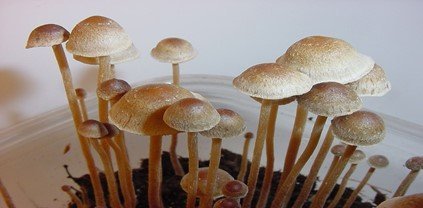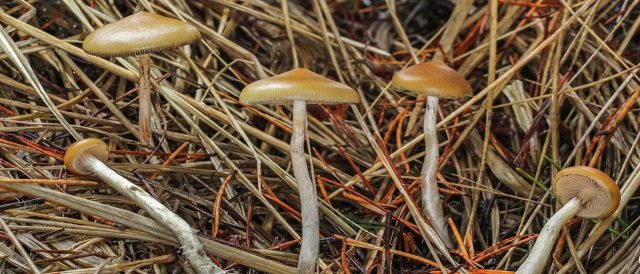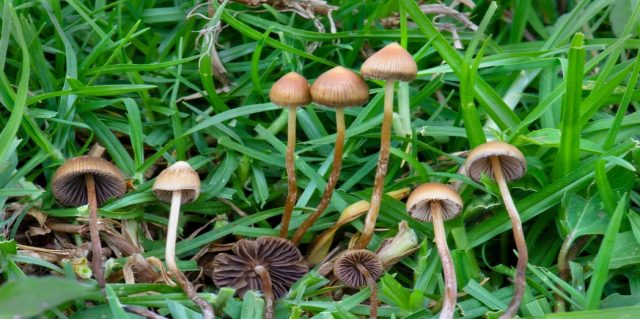The Flavor Profile and Characteristics of the Most Popular Psilocybin Varieties
With more than 180 species of psilocybin mushrooms, including the famous psilocybin cubensis, grow wildly around the globe. With that said, today, we’ll take a look at the unique profiles and characteristics of psilocybin varieties.
#1: Psilocybe Semilanceata (Liberty Caps)

Synopsis:
Psilocybe Semilanceata, also known as Liberty Caps, are considered the most widespread naturally growing psilocybin mushroom in the world. Not only that, but they’re also the third most potent, according to tests done in 1997 by Paul Stamets and Jochen Gartz, a German chemist and mycologist.
- Identified in 1838, P. Semilanceata was the first psilocybin mushroom native to Europe to be formally recognized. This species is still wildly popular and abundant, especially in England
Liberty caps, also known as Witch’s Hats, grow wildly all over the Northern Hemisphere. They prefer rich and acidic soil, like grasslands, meadows, pastures, and lawns, especially ones fertilized with sheep or cow manure. This is such a common environment around the world (think lawns, gardens, soccer fields) and it’s for that reason that they grow in many countries throughout Europe.
Characteristics:
Liberty Caps have a distinctive conical to bell-shaped cap, up to 2.5 cm in diameter, with a small nipple-like protrusion on the top. They are yellow to brown, covered with radial grooves when moist, and fade to a lighter color as they mature.
Their stripes tend to be slender and long, and the same color or slightly lighter than the cap. The gill attachment to the stipe is narrowly attached, and they are initially cream-colored before tinting purple as the spores mature. The spores are dark purplish brown in mass, ellipsoid in shape, and measure 10.5-15 by 6.5-8.5 micrometres.
Flavour Profile:
Most users describe the taste as being “farinaceous”, or having a rich starch-like taste, similar to flour.
#2: Psilocybe Tampanensis (“Magic Truffles” or “Philosopher’s Stone”)

Synopsis:
Psilocybe Tampanensis is a very rare psychedelic mushroom in the family Hymenogastraceae. Originally collected in the wild in a sandy meadow near Tampa Bay, Florida in 1977, the fungus has never again been reported in Florida, but was later collected in Mississippi. The original Florida specimen was cloned, and descendants remain in wide circulation.
- Psilocybin Tampanensis produces truffles, or sclerotia, which contain psilocybin. These truffles are often called philosopher’s stones, magic truffles, or psilocybin truffles. P. Tampanensis can also fruit into small yellow-brown mushrooms with conic caps, but most folks just grow and eat their sclerotia, which grow underground and contain up to 0.68% psilocybin and 0.32% psilocin, according to Stamets book.
- The experience of magic truffles in comparison to other psilocybin-containing mushrooms is said to be very similar, but depending on the dose, somewhat less intense. That said, it’s also been reported that the body load can be heavier and nausea more common due to the dense nature of the stones.
Characteristics:
The cap ranges in shape from convex or conic with a slight umbo, expanding in age to become flattened or with a slight central depression; it reaches diameters of 1-2.4 cm (0.4-0.9 in). The surface is smooth, not grooved, straw brown, buff to yellowish-grey when dry, with slight bluish tones at the margin, hydrophanous, and somewhat sticky when wet.
The gills are more or less broadly attached to the stem slightly above the bottom of the gill, with most of the gill fused to the stem) and brown to a dark purplish brown in color with lighter edges. The stem is 2-6 cm (0.8-2.4 in) long, 1-2 mm (0.04-0.08 in) thick, and equal in width throughout to slightly enlarged near the base. There are fibrils near the top of the stem.
Flavour Profile
Users have described P. Tampanensis as having a bitter taste.
#3: Psilocybe Azurescens (Flying Saucer Mushrooms)

Synopsis:
- Azurescens, also known as Flying Saucers, Blue Runners, Blue Angels, or Azzies are the strongest psilocybin species that grows in the wild.
- As the story goes, they were originally found by Boy Scouts camping in Oregon in 1979 but weren’t an official species until Paul Stamets identified them in 1996 and published his findings.
- Azurescens are only found on the West coast of the U.S. from California to Washington, and mostly cluster near the Columbia River delta in Oregon. That’s because they prefer to live in sandy soils, such as near dunes and sea grasses, and on loose, decaying wood. They can even withstand pretty chilly temperatures compared to other psilocybin containing mushrooms, from 16 to 24° C (60-75° F). Fortunately, that also makes Azzies easy to cultivate outside for home growers in the U.S. and Europe.
Characteristics:
The cap (pileus) of Psilocybe Azurescens is 30-100 mm in diameter, conic to convex, expanding to broadly convex and eventually flattening with age with a pronounced. The surface is smooth, viscous when moist, covered by a separable gelatinous pellicle; chestnut to ochraceous brown to caramel in color, often becoming pitted with dark blue or bluish black zones.
Flavour Profile:
Users report that it tastes extremely bitter, or starchy.
#4: Psilocybe Zapotecorum

Synopsis:
Psilocybe Zapotecorum is another species native to Mexico that has current and likely ancient ceremonial use. It’s named for the Zapotec indigenous community of southern Oaxaca, and according to Gaston Guzman, it is thought to be the mushroom in many of the ancient ceramic mushroom statues that have been uncovered in Mexico. In the Zapotec language, P. Zapotecorum are referred to as Bado, Badao, and Badao Zoo, which translates to drunk mushroom or possibly, drunk god. In Guzman’s 1983 book, The Genus Psilocybe, he reported this species of mushroom could sometimes be found growing naturally inside the adobe homes of the Zapotec people.
Psilocybe Zapotecorum also grows outside of Mexico, and has been found in subtropical South America, including Colombia, Peru, Brazil, and Argentina. According to Stamets, this sacred shroomy prefers to live in swampy, muddy soil that’s humus rich with leaves and wood debris and is often found in gregarious patches. It can vary in size and shape, with a stem that can grow anywhere between 3 to 36 centimeters that’s typically white but fades to blue then black with age or when bruised. It has a tan to creamy brown cap that’s conical to convex and that can grow between 2 to 13 centimeters.
Characteristics:
The cap is 2-13 cm, conical to convex, and very rarely expanding to plane in age. The margin wavy sometimes with an acute papilla or mamilla, usually umbonate or with a depressed center. In young specimens the margin has a scalloped edge which sometimes curls upwards as the mushroom matures. The cap is yellowish brown to tan, fading to cream-yellow then brown and finally black through age. The flesh is originally white but soon changes to a cyan blue, then quickly to black. The stipe is 3-26 cm long, and 0.5-1 cm thick.
Flavour Profile:
Users have also described the flavour profile as being bitter.
#5: Psilocybe Caerulescens (Landslide Mushrooms)

Synopsis:
Psilocybe Caerulescens are known as Derrumbes(meaning Landslide Mushrooms) in Mexico, where they grow naturally. They were first reported by the scientific community near Montgomery, Alabama, in 1923 on a sugar cane mulch and to this day it can still be found in the Southern US in states like South Carolina and Georgia. However, Psilocybe Caerulescens became famous when curandera Maria Sabina gave mycologist Gordon Wasson thirteen pairs during a Mazatec ritual velada ceremony, which Wasson then wrote about for Life Magazine, when the term magic mushroom was born.
- Derrumbes are still used ceremoniously by the Mazatec people of Oaxaca, Mexico, and continue to grow in the Sierra Madre Mountain range. That’s because they are resilient to the low temperatures and high altitudes of those regions, and because they prefer to live in the former sites of landslides and other regions free of plants during the Mexican rainy season (May/June until September/October). They’ve been cultivated outside for centuries, and according to Stamets, can also be found growing in Venezuela and Brazil.
Characteristics:
Derrumbes are small, with stems ranging from 40 to 120 mm (1.5 to 4 in) and have a silvery-blue metallic luster that makes them easy to differentiate from other species. Their potency is low to moderate, and the trip can even be a bit shorter, lasting from three to six hours. They’re a good introduction to magic mushrooms for this reason but can also be a disappointment to those with Psilocybe cubensis experience who travel to Mexico to try them.
Flavour Profile:
Users have described the flavour profile as being mildly starchy but having a walnut undertone.
#6: Psilocybe Mexicana (Teonanacatl Pajarito)

Synopsis:
Psilocybe Mexicana has a rich history. It’s believed that this is the species of mushroom that the Nahuatl or Aztec people used ceremoniously and called Teonanacatl, meaning flesh of the Gods, before Spanish colonization. P. Mexicana is also the species that French botanist Roger Heim sent to Albert Hoffman in 1958. Hoffman, the chemist who discovered LSD, used that sample to cultivate more magic mushrooms and isolate psilocybin and psilocin for the first time in a lab.
- Psilocybe Mexicana still grows to this day in Mexico during the rainy season, especially in the states of Oaxaca, Michoac’n, Puebla, and others. The species is common at altitudes between 1000 and 1800 meters (3280 to 5900 feet). This variety prefers to live in moss, meadows, deciduous forests, and soils rich in manure, as well as alongside roads and trails but never directly on dung.
- In Mexico today they’re often called “Pajarito” meaning “little birds” for packing such a potent experience into such a small, fragile mushroom. They somewhat look like Liberty Caps and live-in similar environments, Paul Stamets has taken to calling them “Mexicana Liberty Caps.” They can also grow truffles or sclerotia, which contain both psilocybin and psilocin. However, their fruiting bodies generally contain more psilocybin, psilocin, and baeocystin according to Psillow.
Characteristics:
(0.5)1-2(3) cm in diameter, conic to campanulate or subumbonate, and often with a slight papilla, hygrophanous or glabrescent, even to striate at the margin, ocherous to brown or beige to straw color in age, sometimes with blueish or greenish tones, easily turning blue when injured.
Favour Profile:
Users describe the flavour as being farinaceous and or starchy.
#7: Psilocybe Caerulipes (Blue Foot Mushroom)

Synopsis:
Psilocybe Caerulipes, also known as the Blue Foot Mushroom, is a rare psilocybin mushroom that grows in the US. It’s a wood loving mushroom and can be found growing on or around decaying hardwood logs, especially near river systems, writes Stamets. They can also be found growing on hardwood slash and debris and are “widely distributed east of the Great Plains throughout the Midwest and the Eastern US and up to Canada. Although widely distributed, P. Caerulipes is not found frequently, but when they grow on forest floors after warm summer and fall rains, they’re known to fruit in the same place for years.
Characteristics:
Blue Foot mushrooms are named for their appearance: They have a blue hue at the base of their stem. They are a moderately potent psilocybin mushroom, roughly the same strength as Psilocybe cubensis. Psillow warns that the experience could possibly be strong, so start small with one to three grams of dried mushrooms before diving into headier experiences.
The cap is 1-3.5 cm in diameter, obtusely conic to convex, and the margin is initially turned inwards, later becoming broadly convex to flattened or somewhat umbilicate while retaining a slight umbo, and at times quite irregular. The flesh is thin, pliant, bruising blue, sometimes slowly.
Flavour Profile:
Users describe it as has having a farinaceous taste.
#8: Psilocybe Stuntzii (Blue Ringer, Stuntz’s Blue Legs)

Synopsis:
Psilocybe Stuntzii is a rare psilocybin mushroom that only grows in the West Coast of the US and Canada. It was first found on the University of Washington’s campus and named for Dr. Daniel Stuntz, who made the first type collection. Their nicknames blue ringer or blue legs come from the significant bluing reaction that occurs when handled.
- Blue Ringers are also wood loving mushrooms and prefer to live on decaying debris, fresh mulch and wood chips. They can be found in grassy areas, as well, like fresh sod and well-manicured lawns, or along roads, paths, and gardens, according to Stamets. He also says that these mushrooms can fruit in prodigious colonies within 90 kilometers (56 miles) of Oregon Washington’s, and British Columbia’s coastal regions. However, be warned that Blue Ringers look very similar to a toxic species of mushroom, Galerina Marginata.
- Stuntzii will be sticky to the touch when moist, unlike G. Marginata, and Stamets writes that Galerina’s orangish brown cap and rusty brown spores distinguish it. Always be careful when collecting mushrooms and never ingest something you can’t absolutely identify.
Characteristics:
Obtusely conic to convex, expanding to convex-umbonate or flat with age. The margin is translucent-striate when moist and uplifted in age. It is hygrophanous, glabrous, dark chestnut brown while lighter towards the center. The pileus is olive-greenish at times, fading to a pale yellowish brown or pale yellow. It is viscid when moist from a gelatinous pellicle, staining slightly greenish-blue when injured or with age.
Flavour Profile:
Users describe the taste as being bitter and nutty.


